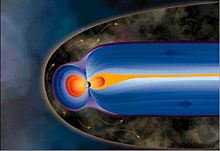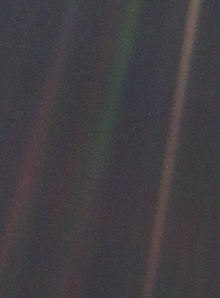Spaceship Earth
Spaceship Earth ( English Spaceship Earth ) is a metaphor that given the limited resources of the planet Earth and the resulting global problems of humanity with the crew of a spaceship equates. It can thus be understood in the globalized space age as a new version of the phrase “We are all in the same boat”. The metaphor was frequently rezipiert and among others with the message "The spaceship Earth has no emergency exit" an important rhetorical image in the discussion about environmental problems .
Henry George 1879
The image of the earth as a ship in space was demonstrably used for the first time in 1879 by the American economist Henry George in his work Progress and Poverty :
"It is a well-provisioned ship, this on which we sail through space."
"It is a well-equipped ship on which we travel through space."
Use in the 1960s and 1970s


With the beginning of the space age and the modern environmental movement in the 1960s, the term "spaceship earth" was used and spread by various people.
The American philosopher and inventor Richard Buckminster Fuller allegedly used the term as early as 1951 in a discussion about the American missile program. He was best known for his book Operating Manual for Spaceship Earth , published in 1968.
In 1965, Adlai Stevenson , previously US governor and two-time presidential candidate, spoke on the United Nations Economic and Social Council five days before his death :
“We travel together, passengers on a little space ship, dependent on its vulnerable reserves of air and soil; all committed for our safety to its security and peace; preserved from annihilation only by the care, the work, and, I will say, the love we give our fragile craft. We cannot maintain it half fortunate, half miserable, half confident, half despairing, half slave - to the ancient enemies of man - half free in a liberation of resources undreamed of until this day. No craft, no crew can travel safely with such vast contradictions. On their resolution depends the survival of us all. "
“We travel together, travelers on a small spaceship, depending on its endangered reserves of air and earth; all committed to his protection and peace for our own security; saved from annihilation only through the care, work and, I would like to say, the love we give to the fragile vehicle. We cannot maintain it half happy, half miserable, half confident, half desperate, half slave - the ancient enemies of men - half free, with a release of resources never dreamed of to this day. No vehicle, no crew can travel safely with such enormous contradictions. Our survival depends on their dissolution. "
A friend of Stevenson's, internationally influential economist Barbara Ward , titled her book on sustainable development Spaceship Earth in 1966 .
Also in 1966, the American economist Kenneth E. Boulding used the phrase in the title of his essay The Economics of the Coming Spaceship Earth .
“The closed economy of the future could accordingly be called the» spaceman «economy. The earth has become a single spaceship, on which all the stores that could be tapped or polluted are limited, so that humans have to find their place in a cyclical ecological system, which can, however, continuously reproduce in material form Energy input. "
Boulding's text is an attempt at a theoretical foundation of a non-growth-oriented economy and his central contribution to the environmental debate of the time. It has been widely accepted by ecological economists .
With his book Our Blue Planet , published in 1965, Heinz Haber coined the common term for the image of the earth, as it penetrated the general consciousness through the photos from space that have now been published. In 1968 recordings showing the entire blue planet appeared on the first edition of the Whole Earth Catalog and then on Earthrise . James Lovelock brought this to the formulation of the Gaia Hypothesis .
The UN Secretary General U Thant spoke of "Spaceship Earth" in 1971 during the ceremony of the ringing of the World Peace Bell in New York .
"Fukushima 2011"

A compilation of past contributions on the state of the earth, also with a view to the development of the term Anthropocene , by Paul Crutzen , Mike Davis , Michael D. Mastrandrea, Stephen H. Schneider and Peter Sloterdijk had the title Das in 2011 - after the Fukushima nuclear disaster Spaceship Earth has no emergency exit .
The metaphor of the earth as a spaceship allowed the authorship to “reconcile the triumph of the natural and technical sciences on the one hand and the ideas of the fragility of life on the other”. No other picture was able to “ better express the predicament of the later 20th century ” and to represent crisis and progress as central figures at the same time. Over the years, the metaphor was able to establish itself as a spatial representation for the “ limits of growth ”.
Overview effect
Ever since the earth was viewed and perceived by people from outer space , astronauts experienced the “ overview effect ” at first sight , which has changed the perspective of the planet and the humanity living on it for many.
“One of the characteristics of Spaceship Earth is that nobody can get out. We have to continue the journey through space together, whether we like all fellow travelers or not. "
See also
literature
- Nicola Armaroli , Vincenzo Balzani : Energy for a Sustainable World - From the Oil Age to a Sun-Powered Future , Wiley-VCH 2011, ISBN 978-3-527-32540-5
- Nicola Armaroli, Vincenzo Balzani and Nick Serpone: Powering Planet Earth - Energy Solutions for the Future , Wiley-VCH 2013, ISBN 978-3-527-33409-4
- Sabine Höhler, Fred Luks, Association for Ecological Economy (ed.): Beam us up, Boulding! 40 years of "Spaceship Earth" . 2006, ISBN 978-3-9811006-1-7
- Sabine Höhler: Spaceship Earth in the Environmental Age, 1960-1990 , London 2014, ISBN 978-1-84893-509-9
Web links
- Die Weltwoche , Edition 42/2001, Susanne Hegglin, weltwoche.ch: Zerbrechliche Welt: Mental Journey ( Review of the Earth as a work of art. Satellite images from space . )
- In search of the integral culture . ( Memento from March 7, 2016 in the Internet Archive ) Spaceship Earth. How seeing the earth from space changed the world.
Individual evidence
- ↑ On this expression, see Anna Lewandowska: Proverbs-Usage Today: an intercultural-contrastive comparison of proverbs using Polish and German print media. Verlag Peter Lang, 2008, p. 281
- ^ Paul Crutzen , Mike Davis , Michael D. Mastrandrea, Stephen H. Schneider , Peter Sloterdijk (Eds.). Spaceship Earth has no emergency exit . Suhrkamp Verlag Berlin, ISBN 978-3-518-06176-3 (October 28, 2016)
- ↑ a b Fred Luks: Bouldings "Spaceship Earth": An ecological-economic classic . In: Association for Ecological Economics , voeoe.de: Beam us up, Boulding! 40 years of "Spaceship Earth" . Articles and reports 7/2006 , ISBN 978-3-9811006-1-7 , pages 30-42
- ↑ a b c d e Sabine Höhler: "Spaceship Earth", a mythical figure of the environmental age. In: Association for Ecological Economics , voeoe.de: Beam us up, Boulding! 40 years of "Spaceship Earth" . Articles and reports 7/2006 , ISBN 978-3-9811006-1-7 . Pages 43-52.
- ^ Henry George: Progress and Poverty. Reprint of the 1879 edition, Verlag Cosimo, 2005, Book IV, Chapter 2, p. 173
- ^ Richard Buckminster Fuller : Operating Manual for Spaceship Earth. Carbondale , Southern Illinois University Press , 1968.
- ↑ Richard Buckminster Fuller : Operating Instructions for Spaceship Earth and other writings. Rowohlt, Reinbek 1973, ISBN 3-499-25013-6 .
- ↑ Adlai Stevenson : Speech of July 9, 1965 , at bartleby.com (accessed August 7, 2014)
- ↑ Barbara Ward : Spaceship Earth . 1966. Boston: Houghton Mifflin Co, ISBN 978-0-231-08586-1 .
- ↑ Kenneth E. Boulding : arachnid.biosci.utexas.edu: The Economics of the Coming Spaceship Earth . In: Henry Jarrett (Ed.): Environmental Quality in a Growing Economy . Essays from the Sixth RFF Forum on Environmental Quality . Baltimore , The Johns Hopkins Press , 1966. pp. 3-14.
- ↑ Kenneth E. Boulding : The economics of the future spaceship earth. Translated by Lexi von Hoffmann. In: Beam us up, Boulding! 40 years of "Spaceship Earth" . Association for Ecological Economy - Articles and Reports 7/2006, ISBN 978-3-9811006-1-7 . Pages 9-21.
- ↑ Blake Alcott: Kenneth Bouldings Guide from 1966 . In: Association for Ecological Economics , voeoe.de: Beam us up, Boulding! 40 years of "Spaceship Earth" . Articles and reports 7/2006, pages 25–29
- ↑ Lovelock, James E. (1996): The Gaia Hypothesis. In: Bunyard, Peter (Ed.): Gaia in Action. Science of the Living Earth. Edinburgh: Floris. P. 16.
- ↑ “May there only be peaceful and cheerful Earth Days to come for our beautiful Spaceship Earth as it continues to spin and circle in frigid space with its warm and fragile cargo of animate life.” ( U Thant , 1971. Quoted from: Lee Lawrence : Earth Day: Past, Present, Future . Retrieved on August 7, 2014. , German: “May the future Earth Days be peaceful and peaceful for our beautiful spaceship Earth, while it rotates in cold space with its warm, fragile, living cargo be happy.")
- ↑ suhrkamp.de ; Review on Deutschlandfunk , accessed May 16, 2015
- ↑ Kuchenbuch, David: Review of: S. Höhler: Spaceship Earth in the Environmental Age, 1960–1990. Retrieved November 10, 2018 .
- ↑ Description of The Overview Effect. The first interdisciplinary evaluation of 20 years of space travel at amazon.de (accessed August 10, 2014)

